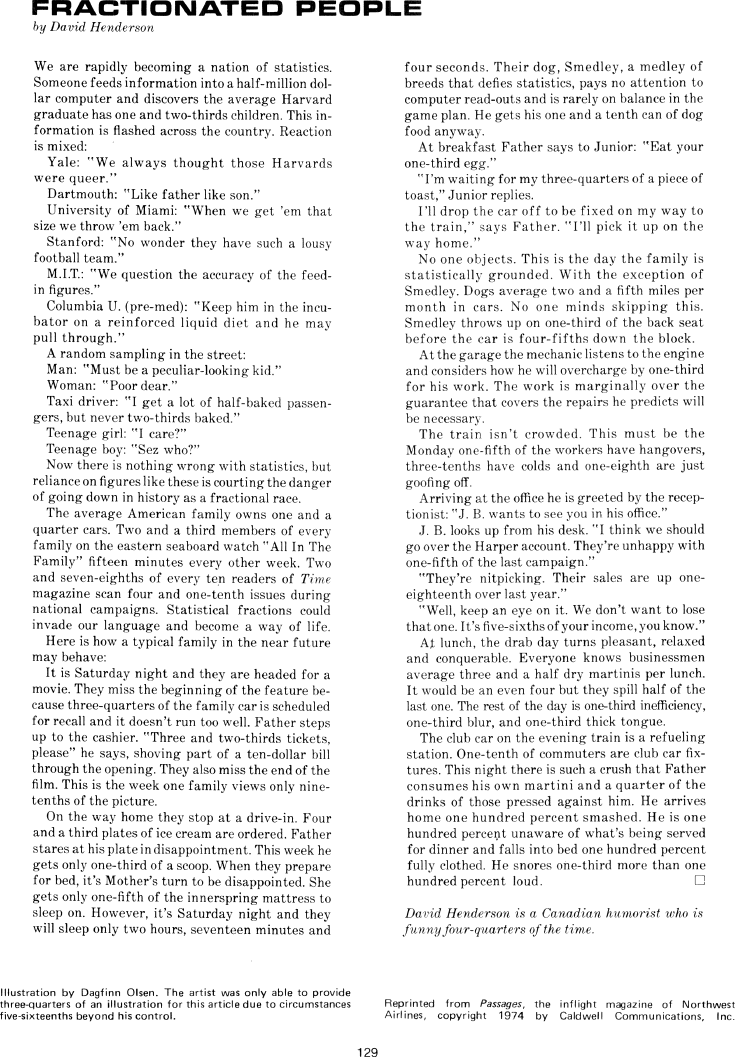The Best of Creative Computing Volume 1 (published 1976)
Fractionated People

FRACTIONATED PEOPLE
by David Henderson
We are rapidly becoming a nation of statistics. Someone feeds information into a
half-million dollar computer and discovers the average Harvard graduate has one
and two-thirds children. This information is flashed across the country.
Reaction is mixed:
Yale: "We always thought those Harvards were queer."
Dartmouth: "Like father like son."
University of Miami: "When we get 'em that size we throw 'em back."
Stanford: "No wonder they have such a lousy football team."
M.I.T.: "We question the accuracy of the feed-in figures."
Columbia U. (pre-med): "Keep him in the incubator on a reinforced liquid diet
and he may pull through."
A random sampling in the street:
Man: "Must be a peculiar-looking kid."
Woman: "Poor dear."
Taxi driver: "I get a lot of half-baked passengers, but never two-thirds baked."
Teenage girl: "I care?"
Teenage boy: "Sez who?"
Now there is nothing wrong with statistics, but reliance on figures like these
is courting the danger of going down in history as a fractional race.
The average American family owns one and a quarter cars. Two and a third members
of every family on the eastern seaboard watch "All In The Family" fifteen
minutes every other week. Two and seven-eighths of every ten readers of Time
magazine scan four and one-tenth issues during national campaigns. Statistical
fractions could invade our language and become a way of life.
Here is how a typical family in the near future may behave:
It is Saturday night and they are headed for a movie. They miss the beginning of
the feature because three-quarters of the family car is scheduled for recall and
it doesn't run too well. Father steps up to the cashier. "Three and two-thirds
tickets, please" he says, shoving part of a ten-dollar bill through the opening.
They also miss the end of the film. This is the week one family views only nine
tenths of the picture.
On the way home they stop at a drive-in. Four and a third plates of ice cream
are ordered. Father stares at his plate in disappointment. This week he gets
only one-third of a scoop. When they prepare for bed, it's Mother's turn to be
disappointed. She gets only one-fifth of the innerspring mattress to sleep on.
However, it's Saturday night and they will sleep only two hours, seventeen
minutes and four seconds. Their dog, Smedley, a medley of breeds that defies
statistics, pays no attention to computer read-outs and is rarely on balance in
the game plan. He gets his one and a tenth can of dog food anyway.
At breakfast Father says to Junior: "Eat your one-third egg."
"I'm waiting for my three-quarters of a piece of toast," Junior replies.
I'll drop the car off to be fixed on my way to the train," says Father. "I'll
pick it up on the way home."
No one objects. This is the day the family is statistically grounded. With the
exception of Smedley. Dogs average two and a fifth miles per month in cars. No
one minds skipping this. Smedley throws up on one-third of the back seat before
the car is four-fifths down the block.
At the garage the mechanic listens to the engine and considers how he will
overcharge by one-third for his work. The work is marginally over the guarantee
that covers the repairs he predicts will be necessary.
The train isn't crowded. This must be the Monday one-fifth of the workers have
hangovers, three-tenths have colds and one-eighth are just goofing off.
Arriving at the office he is greeted by the receptionist: "J. B. wants to see
you in his office."
J. B. looks up from his desk. "I think we should go over the Harper account.
They're unhappy with one-fifth of the last campaign."
"They're nitpicking. Their sales are up one-eighteenth over last year."
"Well, keep an eye on it. We don't want to lose that one. It's five-sixths of
your income, you know."
At lunch, the drab day turns pleasant, relaxed and conquerable. Everyone knows
businessmen average three and a half dry martinis per lunch. It would be an even
four but they spill half of the last one. The rest of the day is one-third
inefficiency, one-third blur, and one-third thick tongue.
The club car on the evening train is a refueling station. One-tenth of commuters
are club car fixtures. This night there is such a crush that Father consumes his
own martini and a quarter of the drinks of those pressed against him. He arrives
home one hundred percent smashed. He is one hundred percent unaware of what's
being served for dinner and falls into bed one hundred percent fully clothed. He
snores one-third more than one hundred percent loud.
David Henderson is a Canadian humorist who is funny four-quarters of the time.
Illustration by Dagfinn Olsen. The artist was only able to provide
three-quarters of an illustration for this article due to circumstances
five-sixteenths beyond his control.
Reprinted from Passages, the inflight magazine of Northwest Airlines, copyright
1974 by Caldwell Communications, Inc.


